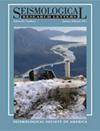Global Seismic Networks Operated by the U.S. Geological Survey
IF 3.2
3区 地球科学
Q2 GEOCHEMISTRY & GEOPHYSICS
引用次数: 0
Abstract
The U.S. Geological Survey (USGS) Global Seismographic Network (GSN) Program operates two thirds of the GSN, a network of state-of-the-art, digital seismological and geophysical sensors with digital telecommunications. This network serves as a multiuse scientific facility and a valuable resource for research, education, and monitoring. The other one third of the GSN is funded by the National Science Foundation (NSF), and the operations of this component are overseen by EarthScope. This collaboration between the USGS, EarthScope, and NSF has allowed for the development and operations of the GSN to be a truly multiuse network that provides near real-time open access data, facilitating fundamental discoveries by the Earth science community, supporting the earthquake hazards mission of the USGS, benefitting tsunami monitoring by the National Oceanic and Atmospheric Administration, and contributing to nuclear test monitoring and treaty verification. In this article, we describe the installation and evolution of the seismic networks operated by the USGS that ultimately led to the USGS portion of the GSN (100 stations under network codes IU, IC, and CU) as they are today and envision technological advances and opportunities to further improve the utility of the network in the future. This article focuses on the USGS-operated component of the GSN; a companion article on the GSN stations funded by the NSF and operated by the Cecil and Ida Green Institute of Geophysics and Planetary Physics, Scripps Institution of Oceanography, University of California at San Diego by Davis et al. (2023) appears in this volume.美国地质调查局运营的全球地震网络
美国地质调查局(USGS)的全球地震网络(GSN)计划运营着三分之二的全球地震网络,这是一个由最先进的数字地震和地球物理传感器以及数字通信组成的网络。该网络是一个多用途科学设施,也是研究、教育和监测的宝贵资源。全球地震台网的另外三分之一由美国国家科学基金会(NSF)资助,该部分的运行由地球观测站(EarthScope)负责监督。美国地质调查局、EarthScope 和美国国家科学基金会之间的合作使全球海洋观测网的开发和运行成为一个真正的多用途网络,提供近乎实时的开放数据,促进地球科学界的基础发现,支持美国地质调查局的地震灾害任务,有利于美国国家海洋和大气管理局的海啸监测,并有助于核试验监测和条约验证。在本文中,我们将介绍由美国地质调查局运营的地震台网的安装和演变过程,最终形成了今天的全球地震台网美国地质调查局部分(100 个台站,台网代码分别为 IU、IC 和 CU),并展望了未来进一步提高台网效用的技术进步和机遇。本文重点介绍全球海洋观测网中由美国地质调查局运营的部分;本卷还将刊载 Davis 等人(2023 年)撰写的关于由美国国家科学基金会资助、由加州大学圣地亚哥分校斯克里普斯海洋学研究所塞西尔和艾达-格林地球物理与行星物理研究所运营的全球海洋观测网台站的文章。
本文章由计算机程序翻译,如有差异,请以英文原文为准。
求助全文
约1分钟内获得全文
求助全文
来源期刊

Seismological Research Letters
地学-地球化学与地球物理
CiteScore
6.60
自引率
12.10%
发文量
239
审稿时长
3 months
期刊介绍:
Information not localized
 求助内容:
求助内容: 应助结果提醒方式:
应助结果提醒方式:


